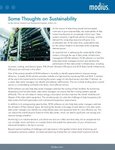Despite their own sustainability claims, big cloud players are forcing their colocation landlords to waste energy on their behalf, according to industry experts.
While hyperscalers are saving energy and emissions by increasing the temperature in their own facilities, they are causing waste in rented space.
Companies such as Amazon, Google, Meta, and Microsoft are insisting on contract terms that make third-party operators keep data centers cooler than necessary, according to statements from Sabey Data Centers president Rob Rockwood, reported by Bisnow.
Data centers typically spend about a third of the energy they use in keeping the environment cool by removing heat from IT equipment, but this can be reduced if operators adjust the settings of their cooling systems, allowing temperatures to rise.
Historically data centers have been kept at around 20°C to 22°C, but groups such as ASHRAE have advised organizations to set thermostats higher for years. Back in 2008, Intel ran 450 servers for 10 months with no external cooling, allowing temperatures to reach 33.3°C, with no ill effects.
Public statements from the hyperscalers have backed this movement. In experiments and production sites, Facebook raised its temperatures to 29.4°C, Google went up to 26.6°C, and Microsoft has published guidelines suggesting temperatures could go up to 27°C. Colocation provider Equinix has also taken steps to increase facility temperatures in partnership with its colocation customers.
However, it appears they may be limiting these efforts to facilities that they own, or lease outright. Speaking at a Bisnow event, Rockwood said that hyperscalers apply different rules when they rent wholesale colocation space, insisting on contract terms that keep hall temperatures lower than necessary and demand that facility owners waste energy cooling them down.
Colo providers want to change cooling standards, but the hyperscalers are apparently refusing to cooperate.
“If we as an industry could get more reasonable [contracts] for what goes on inside a data center, it would decrease the cost to deliver it, it would decrease the cost of the lease, and it would decrease the amount of power that gets used,” Rockwood told Bisnow. “It would very much be a more efficient operation overall.”
As well as running their own facilities, hyperscalers rent large suites of wholesale colocation space, under contracts that specify parameters including operating temperatures. Failure to meet these terms can result in financial penalties or the end of the colocation contract.
Rockwood and other executives say that hyperscalers are insisting on outdated temperatures within their colocation SLAs, even when new SLAs are negotiated.
Bisnow suggests this is because hyperscalers' procurement teams are incentivized to force operators to agree to their standard contracts, even when their own environmental, social, and governance (ESG) teams would want higher temperatures, and their sustainability reports claim that their own data centers are running warmer.
Stuart Lawrence of Stream Data Centers told the site that these draconian SLAs push colo providers to build to even higher levels of cooling: “We’ll generally design based on the worst-case scenario.”
DCD has asked for more information on this from AWS, Microsoft and Google.




